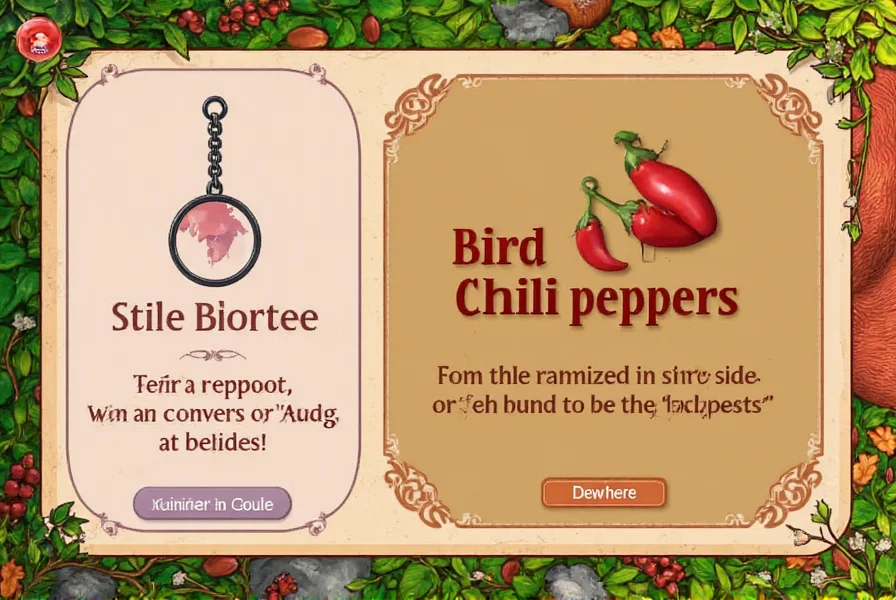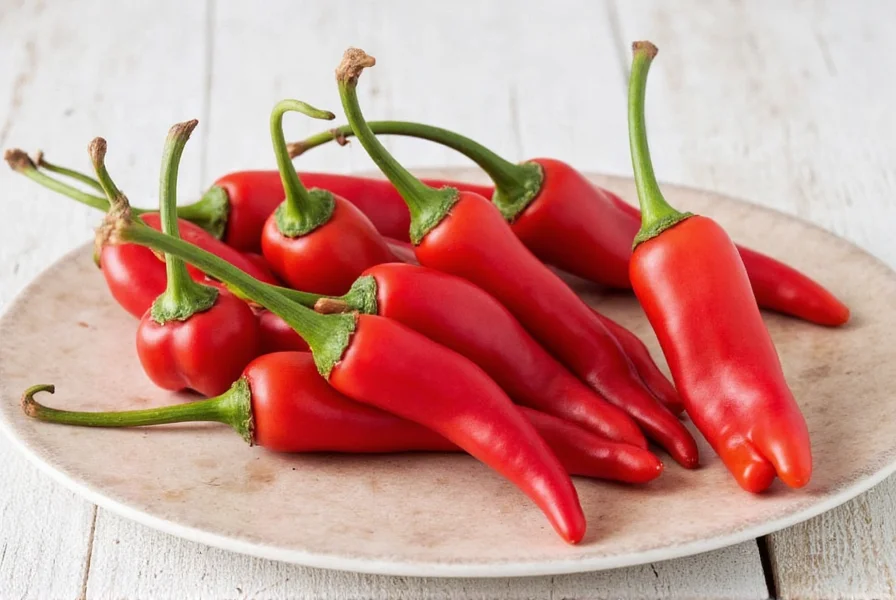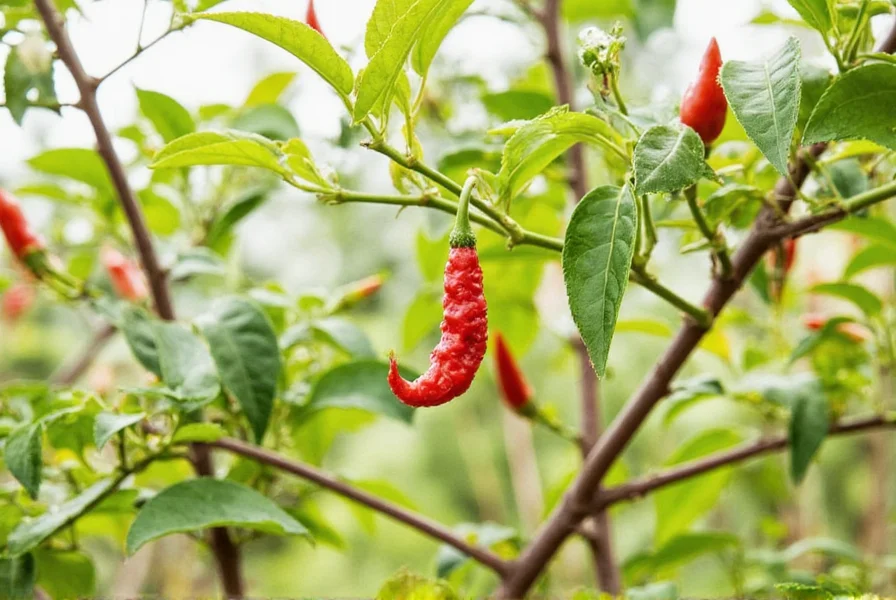Bird Chili Peppers: Heat Level, Cooking Guide & Safety Tips (2025)
Bird chili peppers (also known as bird's eye chilies) are small, intensely hot peppers native to Southeast Asia, commonly used in Thai, Indian, and African cuisines. With a Scoville Heat Unit (SHU) range of 50,000–100,000, they're 10-20 times hotter than jalapeños but significantly milder than ghost peppers. This guide covers everything you need to know about using bird chilis safely and effectively in your cooking.
Table of Contents
Understanding the Spice Level
Bird chili peppers typically range between 50,000–100,000 Scoville Heat Units (SHU), making them significantly hotter than jalapeños (2,500–8,000 SHU) but milder than ghost peppers (850,000–1,040,000 SHU). The heat level can vary based on growing conditions, but even a single pepper can cause intense burning sensations. For beginners, start with half a pepper and gradually increase usage as your tolerance builds.
| Pepper Type | Scoville Range |
|---|---|
| Jalapeño | 2,500 – 8,000 |
| Bird Chili Pepper | 50,000 – 100,000 |
| Ghost Pepper | 850,000 – 1,040,000 |
| Carolina Reaper | 1,400,000 – 2,200,000 |

Cooking Tips with Bird Chili Peppers
Mastering bird chili peppers requires understanding how to handle and incorporate them into dishes without overwhelming flavors. Here are expert-tested techniques:
- Wear gloves when handling: Capsaicin oils can cause severe skin irritation. Always use protective gloves during preparation.
- Remove seeds and membranes: These contain 80% of the capsaicin. Removing them reduces heat while preserving flavor.
- Toast dried chilis: Dry-toast in a pan for 30-60 seconds to enhance smoky notes before grinding into powder.
- Balance with fat and acid: Pair with coconut milk, yogurt, or lime juice to neutralize heat while enhancing flavor complexity.
- Start small: Use 1/4 of a pepper for soups or stews, then adjust to taste. Overuse can ruin a dish.
- Freeze fresh chilis: Store whole in freezer bags for up to 6 months. No need to thaw before use.

Buying Guide: How to Choose the Best Bird Chilis
When purchasing bird chili peppers, focus on freshness and variety to match your culinary needs:
Key Buying Criteria
- Color: Bright red or orange indicates peak freshness. Avoid dull or wrinkled peppers.
- Firmness: Should feel solid with no soft spots or mold. Slightly wrinkled is okay for dried varieties.
- Smell: Fresh chilis have a sharp, pungent aroma. Avoid any musty or fermented smells.
Common Varieties and Uses
- Thai Bird's Eye Chili: Most common variety. Ideal for Thai curries, stir-fries, and hot sauces. Heat level: 50,000-100,000 SHU.
- Malagueta Pepper (Brazil): Fruity and smoky. Perfect for moqueca and caipirinhas. Heat level: 60,000-100,000 SHU.
- Dried Bird Chili: Longer shelf life. Best for spice blends and dry rubs. Rehydrate before use for maximum flavor.

Myths and Facts About Bird Chili Peppers
Separating fact from fiction helps you use bird chilis more effectively:
- Myth: All bird chilis taste the same.
Fact: Varieties differ significantly. Thai bird chilis are citrusy, Malagueta has smoky notes, and African bird chilis are earthier. - Myth: You need to eat the whole pepper to get the heat.
Fact: Capsaicin concentrates in seeds and white membranes. Removing these reduces heat while keeping flavor. - Myth: Drinking water helps cool the burn.
Fact: Water spreads capsaicin. Use dairy (milk, yogurt) or oil-based solutions instead.

Frequently Asked Questions
How do I safely handle bird chili peppers?
Always wear food-safe gloves when handling. Never touch your face, especially eyes. After handling, wash hands with soap and milk (not water) to neutralize capsaicin. Clean all surfaces with vinegar or rubbing alcohol.
What's the best way to reduce heat in a dish with bird chilis?
Add dairy products (yogurt, coconut milk), fats (butter, olive oil), or sugars (honey, brown sugar). Acidic ingredients like lime juice also help balance heat without diminishing flavor.
Can I substitute bird chili peppers with other peppers?
For similar heat, use cayenne or serrano peppers but reduce quantity by 50%. For milder alternatives, try jalapeños or poblano peppers. Always taste as you go – heat levels vary by growing conditions.
How long do bird chili peppers last?
Fresh: 2-3 weeks refrigerated in a paper bag. Dried: 6-12 months in airtight containers. Frozen whole: up to 6 months. Always check for mold before use.
What are the health benefits of bird chili peppers?
Rich in vitamin C (3x more than oranges) and capsaicin, which may boost metabolism, reduce inflammation, and improve circulation. Always consult a doctor before using for medicinal purposes.

Conclusion
Bird chili peppers are a versatile ingredient that adds complex heat and flavor to any dish when used correctly. By understanding their heat profile, mastering safe handling techniques, and pairing them with complementary ingredients, you can elevate your cooking without overwhelming your palate. Start small, experiment gradually, and enjoy the fiery journey!












 浙公网安备
33010002000092号
浙公网安备
33010002000092号 浙B2-20120091-4
浙B2-20120091-4